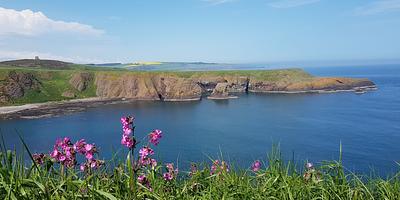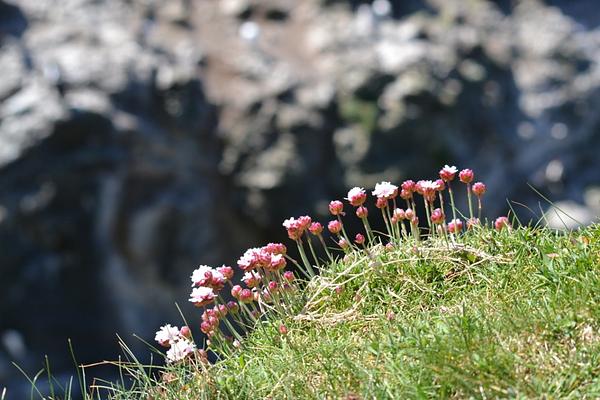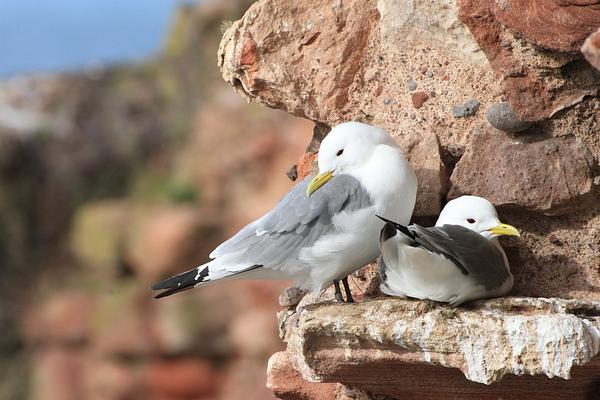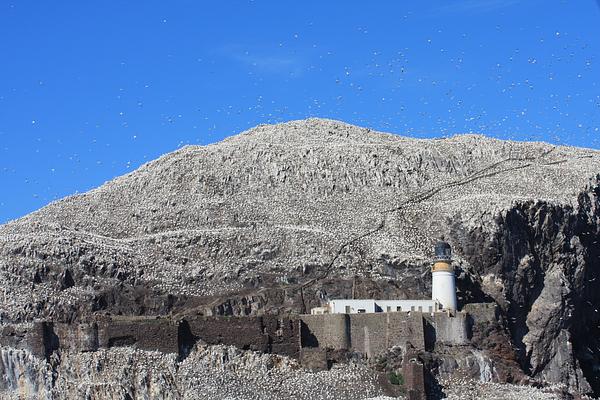
COASTAL CLIFFS
Around Scotland's coastline, cliff habitats range from the gentle slopes of soft rock of Fife to the dramatic, wave-battered rocky cliffs of St Kilda.
FORMATION
Cliffs come in a variety of forms depending on the geology of an area; cliffs made of soft rock erode quickly and are susceptible to land slips, whereas those made of hard rock are much more resilient and can form sheer walls of rock rising from the sea.
Rocky cliffs are often interspersed with geological features such as caves, arches and stacks. Stac an Armin on St Kilda is the UK’s highest sea stack, standing at 196.3m.
Scottish cliffs with soft deposits, i.e. clay, usually overlie bedrock meaning they’re less susceptible to the rapid erosion seen on truly soft cliffs (such as those in East Anglia).
INHABITANTS
Plants
Plants growing on cliffs have to withstand being buffeted by storms and salt spray.
The beautiful pink-purple flowers of thrift (Armeria maritima), also known as ‘sea pink’, is a common sight on both types of cliff top across the UK.

Some plants are specially adapted to life on one particular type of cliff. Maidenhair fern (Adiantum capillus-veneris) and sea spleenwort (Asplenium marinum) are both ferns found on rocky cliffs, whereas colt’s foot (Tussilago farfara) and great horsetail (Equisetum telmateia) are able to grow quickly on disturbed soil – a useful adaptation that allows it to grow on landslip-prone soft cliffs.
Other plants growing on both soft and rocky cliffs are sea spleenwort (Asplenium marinum), portland spurge (Euphorbia portlandica) and rock sea-lavender (Limonium vulgare).
In the northern parts of Scotland, maritime heaths and grasslands occur that support species such as spring squill (Scilla verna) and Scottish primrose (Primula scotica) – a species that grows nowhere else in the world other than Orkney and the northern mainland!
Invertebrates
The majority of invertebrates on cliff environments occur where there is plenty of vegetation. The grayling butterfly (Hipparchia Semele) for example can be found fluttering about cliff tops on a warm, sunny day.
The green tiger-beetle (Cicindela campestris) is a predator that hunts from its burrow built into the sides of soft cliffs.
Birds
Rocky cliff faces are globally recognised as important sites for seabirds. Across the UK coastline, millions of seabirds will nest and raise their young on cliffs each year. In fact, we can boast some of the finest seabird cliffs in Europe.
Cliffs are an ideal place for seabird colonies because their inaccessibility to land animals reduces the risk of predation. They also provide close proximity to good feeding grounds – essential for rearing a fit and healthy chick.

Common seabird species that form breeding colonies on rocky cliff faces along Scottish coastlines include Northern gannet (Morus bassanus), common guillemot (Uria aalge) and blacked-legged kittiwake (Rissa tridactyla).
Other species of non-colonial birds are also found amongst the dense aggregations, inclduing razorbill (Alca torda) and various species of gull. Birds of prey, such as peregrine falcons (Falco peregrinus), also nest on rocky coastal cliffs.
Conversely, the Atlantic puffin (Fratercula artica) requires grassy cliffs for excavating burrows. These burrows are the birthplace of a single chick, or 'puffling', each Summer. Once they've lost their fluffy down, the youngsters head down the cliff to the waters edge and 'jump' in to the sea. The Isle of May and Craiglieth in the Firth of Forth are fantastic places to spot puffins during the breeding season.

The best time to see seabird colonies is April-July - seabird breeding and fledging season. Outside of these months the birds are out at sea, feeding up ready for the next year.
Bass Rock, located just off the shore from the Seabird Centre, is home to the world’s largest colony of Northern gannets with over 500,000 individuals returning to the rock each year. The importance of the location is reflected by its designation as a Site of Special Scientific Interest – somewhere that human activities are restricted by law.

Being close to a seabird colony is quite an experience – the cacophony of calling birds, the sight of parents tenderly rearing their chicks and the smell of guano is something for many of the senses! Experience this for yourself by checking out our live camera feeds from the local islands or taking one of our boat trips for a first-hand experience!
LOCALISED THREATS
- Storms – Increasing in intensity and frequency due to climate change, adverse weather erodes cliffs and a danger to species exposed on cliff edges.
- Overfishing – In addition to the threat of climate change, fish stocks are vulnerable to collapse if fished unsustainably. For seabirds, whose diet primarily consists of fish, the reduction in the availability of this food source would be catastrophic for the survival of colonies. For example, a dramatic drop in numbers of atlantic puffin and black-legged kittiwake numbers was linked to a decrease in the availability of sandeels - a species commercially fished in Scottish waters at the time.
